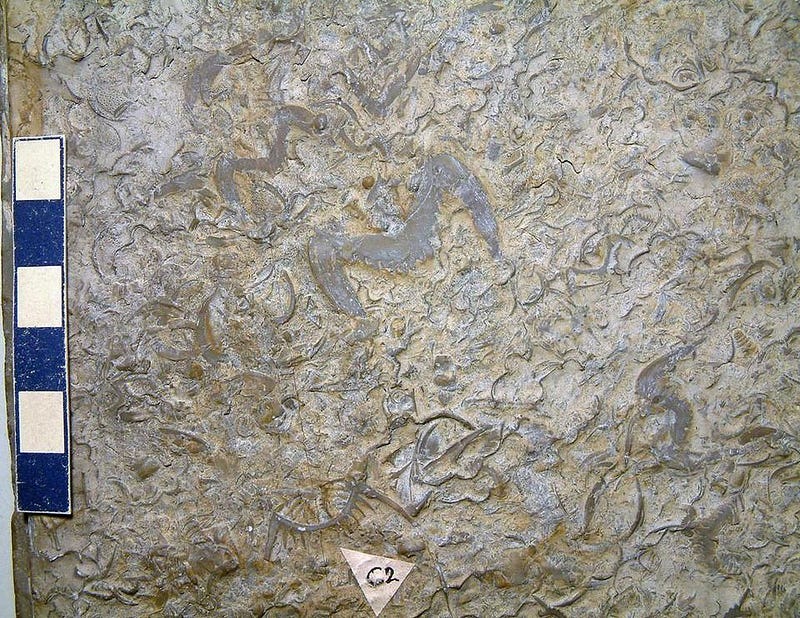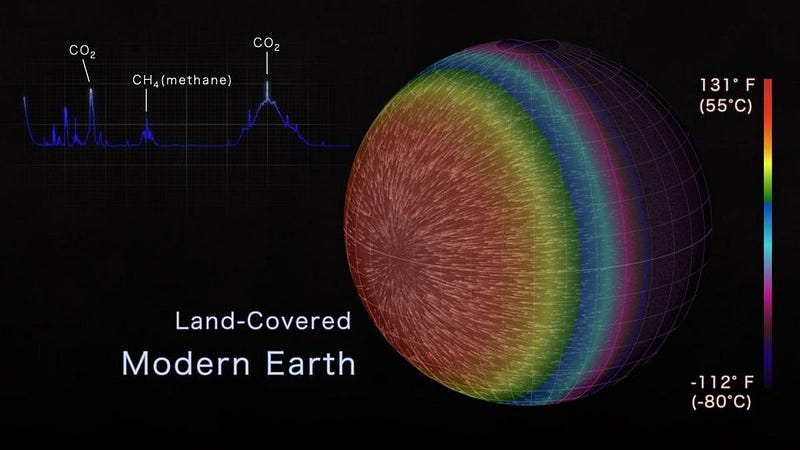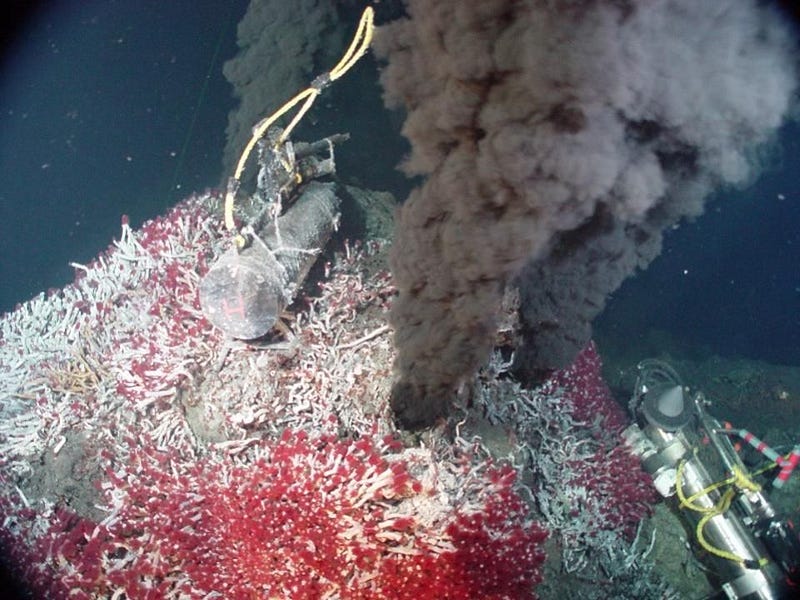Life Might Be Common In The Universe, But Intelligence Is Likely Rare

Extraterrestrial life should arise fairly easily. But intelligence is another matter entirely.
Planet Earth has been around for the past 4.5 billion years or so: about the last third of the Universe’s history. Through a combination of geology and paleontology, we can trace the existence of life back more than four billion years, teaching us that life arose on Earth very early on. If it wasn’t immediately coincident with the formation of our planet — and it may have been — it certainly arose within the first few hundred million years of Earth’s history.
But intelligent life is another story entirely. Life survived and thrived for billions of years before human beings arose: apparently the first intelligent and technologically advanced species on our planet. How likely is life in the Universe? How likely is intelligent life? While we haven’t found either beyond Earth just yet, a new study claims to have determined whether life “rarely” or “commonly” occurs on Earth-like worlds, concluding that life may be common, but intelligence is rare. Here’s why.

It’s very difficult to know what the true probability of life arising on Earth is, or what the odds that intelligent, technologically advanced life would arise. In order to know such a thing, what we’d ideally want to do is to create that same environment that was present on Earth back at the time of its formation many times over, watch each of those environments evolve over ~4.5 billion years, and see what comes out.
That’s how science ideally works at a fundamental level: experimentally. You want to know something about the behavior of a system, so you create that system and observe its behavior over and over again. When you have a large enough sample size, you see what the results are and draw your conclusions based on that. It’s the simplest approach to any scientific question.

For the question of how likely life or intelligent life on an Earth-like world actually is, it’s actually an impossible approach. For starters, we only have one planet (Earth) that we know of where life exists at all, and it’s not like we have Suns and Earth-like planets just waiting around for us to observe them over 4.5 billion year timescales. The idea that we could take a large sample of them and run a controlled experiment is simply not possible in our realistic Universe.
And that’s too bad, because the most straightforward way to think about probability is to do exactly this. You take a large set of prepared samples that have all been prepared identically, you let them evolve under a controlled set of conditions, and you see what comes out. The number of successes — whether you define success by life, intelligent life, or some other criteria — divided by the total number of attempts will give you your probability of success.

In mathematical terms, this is what we call a frequentist probability. In reality, you might only have one planet around one star, but if you could know the outcomes of a very large number of systems that were made of identical planets around identical stars, you’d know what the probability was of your particular planet getting a specific outcome. Just as you know the probability of getting two six-sided dice to sum up to 7 is one-sixth, you could know the probability of life (or intelligent life) arising on Earth.
But in practice, we cannot take this approach for planet Earth. With only one system, we cannot perform the experiment many times and determine the frequency of the desired (and undesired) outcomes. That doesn’t mean we’re hamstrung entirely, however. There’s a different approach we can take: one based on Bayesian probability.

In Bayesian probability, the reasoning goes backwards instead of forwards. What you’re evaluating isn’t the overall probability of outcomes, but rather the probability of one particular hypothesis being valid compared to all the possible hypotheses. It’s the best tool to use when you only have one system with one outcome.
This is tougher to understand, so let’s give an example: planet Earth. We know that life arose on Earth relatively early on. The earliest fossils go back 3.8 billion years and there are zircon deposits that are thought to have a biological origin that go back 4.1-to-4.4 billion years, and our planet is only about 4.5 billion years old. On the other hand, complex life didn’t arise until shortly before the Cambrian explosion (just 600 million years ago), and intelligent, technologically advanced life only came to be with the arrival of human beings.
That’s our one system, along with its outcome.

So, what are the possible hypotheses that could lead to this? Realistically, there are only four.
- Life commonly arises on planets like Earth, and becomes intelligent frequently.
- Life commonly arises on planets like Earth, but becomes intelligent only rarely.
- Life only rarely arises on planets like Earth, but when it does, it becomes intelligent frequently.
- Life only rarely arises on planets like Earth, and when it does, it becomes intelligent only rarely.
If you were to take the frequentist’s dream, you could start off with billions of planets around billions of stars that were decidedly very much like Earth, and watch what unfolded. Unfortunately, we absolutely cannot do that; we don’t even know what it is that makes a world “Earth-like” in any meaningful way.
Could the TRAPPIST-1 worlds be Earth-like? How about one of the planets around TOI-700? Or one of the planets around Alpha Centauri A or B? There is too much we don’t know to even talk about “Earth-like” planets with any confidence whatsoever.

But with Bayesian probabilities, you can do more than just throw up your hands in surrender. You can assume, as a starting point, that each of the relevant questions has a 50:50 probability, where there’s a 50% chance that life arises commonly and a 50% chance that it arises only rarely. Similarly, assuming life arises, there’s then a 50% chance that it becomes intelligent frequently and a 50% chance that it becomes intelligent only rarely.
What you then do is model, based on the probabilities you assumed, how frequently you get an outcome that aligns with the observed results. (In this case, getting life and/or intelligent life out of them in a way that aligns with what happened on Earth.) In a new paper just published on May 18, 2020, David Kipping did exactly this, providing the first robust likelihood analysis of these four scenarios.

Bayesian probabilities cannot tell you what the actual odds of these outcomes are, but they can tell you which hypothesis is more likely — and by how much — which is useful information for “betting odds.” If there’s no meaningful information, the initial probabilities you assumed (50:50 for each case) will be unchanged. However, if the analysis favors one hypothesis over another, you’ll see your betting odds shift in that direction.
The fact that life arose early in Earth’s history is an enormous factor in shifting the betting odds. If you go with the microfossil evidence, it gives you better than 3-to-1 betting odds that life arises commonly rather than rarely; if you use the (disputed, but still compelling) evidence from zircon deposits, the betting odds increase to better than 9-to-1 that life is common rather than rare. If we re-ran Earth’s history many times, we would expect life to arise often, rather than hardly at all.

But the same procedure actually yields very little information about intelligent life. If you start with the same betting odds (50:50) for intelligent life — assuming that life has arisen, is intelligent life common or rare — the Bayesian analysis that Kipping performed slightly favors the rare-intelligence scenario. But the effect is slight, transforming the 1-to-1 betting odds into something that looks more like a 3-to-2 scenario, in favor of rarity.
This does not, however, mean that intelligent life is rare. It means that the information we have doesn’t do a very good job of constraining whether intelligent life’s emergence is rare or common. This is a stark contrast to the question of life’s emergence at all: the data is good enough to conclude that the common-life scenario is more likely than the rare-life scenario. If we started with a clone of early Earth, life would likely emerge, but we cannot reach a good conclusion concerning the emergence of intelligent life.

All of this is what you might expect without any special statistical analysis. Our planet, from the earliest times, was just like any other: a lottery ticket in the cosmic sweepstakes for life and intelligent life. Venus and Mars, among other worlds in our Solar System, had their own tickets as well, and it’s eminently possible that life emerged on all three worlds early on; it certainly did on Earth. Only on our world did life sustain and thrive, however, and eventually give rise to an intelligent species and a technologically advanced civilization.
We cannot turn the clock back and see how things would have turned out, nor do we have technosignature data or a surefire Earth-like exoplanet to help us understand these cosmic likelihoods. However, a clever analysis can reveal that when it comes times to place your bets, bet on life’s emergence as a common occurrence as opposed to a rare one. For intelligence, however, the only information is a slight nudge in the rare direction. To learn anything more, we’ll need data that we don’t yet have.
Ethan Siegel is the author of Beyond the Galaxy and Treknology. You can pre-order his third book, currently in development: the Encyclopaedia Cosmologica.





